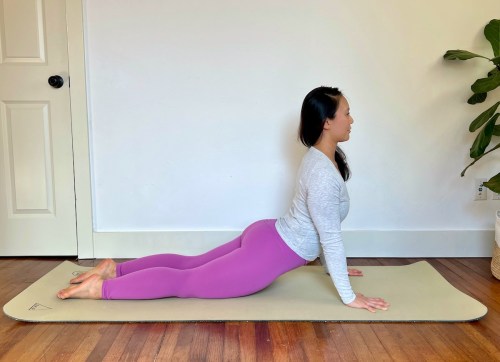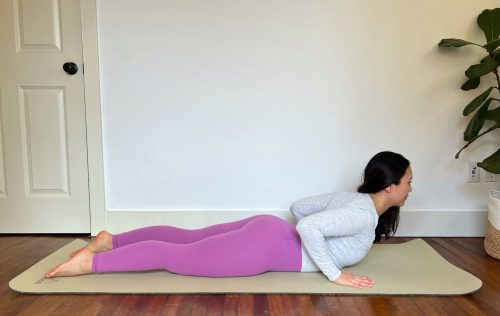Open Your Heart and Release Your Lower Back With Cobra Pose
Dive into the benefits of cobra pose in yoga, learn variations, and discover alignment tips for a balanced practice.

Get ready to slither into the world of cobra pose, also known as bhujangasana in yoga. This isn’t just another yoga pose: It’s your ticket to a stronger, more flexible body, and a heart that’s bursting with joy.
Experts in This Article
founder of Claire Mark Wellness and a yoga teacher with over 20 years of experience.
Cobra pose is a distinctively heart-opening yoga pose, meaning it stretches and expands the chest area. In this comprehensive guide, we’ll delve into its variations, reveal alignment secrets, and show you why this full-body pose is an integral part of your yoga practice.
Claire Mark, E-RYT-500, founder of Claire Mark Wellness and a yoga teacher with over 20 years of experience, loves cobra.
“Depending on how high you lift your chest up from the ground, cobra can be easily adapted for beginners or transformed into a challenging exercise for more advanced yogis,” she says.
- What is cobra pose good for in yoga? Cobra is the go-to pose for increasing hip extension mobility and stretching those stubborn hip flexors. It can improve spinal stability and posture and even strengthen your glutes and core. This pose can especially be helpful to open your chest and give you that metaphorical sense of heart opening, which we could all use more of (and feels so good).
- How long should I hold cobra pose? If you are flowing through a sun salutation, then hold cobra for just one breath. If you are trying to get more of a backbend, breathe in the pose for up to five breath cycles.
- What happens if I do cobra pose every day? How yoga changes your body depends on how often you do it. With daily cobra practice, you’ll enjoy improved flexibility and your spine and hips flexors will be more supple. You will also notice increased strength in your core and arms, and less tension in your chest and hips.
- Why is cobra pose so hard? If you find cobra pose to be challenging, it’s likely due to the deep backbend and arm strength requirement. But with practice, you’ll find it gets easier—and your body will thank you.
Cobra pose is more than just a stretch; it’s a celebration of your body’s ability to move, bend, and thrive. So, unroll that mat, put on your favorite yoga pants, and let’s slither into the wonderful world of cobra pose.
How to do cobra pose
Let’s break it down into easy-to-follow steps. Whether you’re a seasoned yogi or just starting your journey, here’s how to lay the foundation for this fan-favorite heart-opening pose.

- 1.Begin by lying face down on your yoga mat, with your forehead resting on the ground. Keep your legs extended and place your hands directly under your shoulders.
- 2.Scoop your elbows toward your body and spread your fingers wide. This creates a firm foundation with your hands on the mat.
- 3.Press into your hands to lift your chest off the ground, engaging your abdominal muscles.
- 4.Draw your shoulders down your back as you work toward straightening your arms. It’s perfectly fine to maintain a slight bend in your arms if it feels more comfortable for your back.
- 5.Keep engaging your abdominal muscles as you press firmly into your hands, using your arm and core strength to lift your heart up and draw your scapula down your back.
- 6.Balance your head comfortably in line with the curve of your spine as you work toward straightening your elbows without hyperextending them.
- 7.While your pubic bone rests on the mat, lift it slightly toward your chest to lengthen the lumbar spine.
- 8.Remember, it’s not about how high you can lift your chest; focus on the length and comfort of your spine.
- 9.Hold this pose for up to 5 breath cycles, allowing your body to gradually ease into it.
- 10.To release, gently return to your belly and turn one cheek to the mat.
Benefits of cobra pose
Cobra isn’t just about bending backward, and doing it correctly can unlock a treasure chest of benefits.
Chest expansion
“Cobra pose is exceptional in expanding the chest and broadening the space across the collarbones,” Mark says. This is particularly beneficial for those who tend to hunch or spend extensive time sitting or working at a computer.
Hip mobility
Cobra pose adds a dash of hip extension to your routine, which can free up your hip’s range of motion. And as for those pesky, tight hip flexors? Cobra takes care of them by giving them a good, much-needed stretch.
Improved posture
Cobra pose is a fantastic way to promote spinal extension. As you lift your chest and arch your back, you encourage a healthy curvature in the spine, which can counteract the effects of slouching and sitting for long periods.
Mark also points out that, when practiced with less weight in the hands, cobra pose strengthens your erectors (the muscles lining your spine), helping you to attain better posture.
Cobra pose also encourages the elongation of your neck. By lifting your head and chest, you create space between the vertebrae in your neck, reducing tension and promoting better posture.
Stronger glutes and hamstrings
With correct form, you’re not just bending in cobra pose; you’re building strength in your hip extensors and knee flexors, powering up your lower body.
Stronger arms and core
Cobra pose engages the muscles in your arms, particularly the triceps and deltoids, as you press into the mat to lift your chest. Regular practice can help tone and strengthen your arm muscles.
And while cobra primarily targets the muscles in your back, it also activates your core muscles. Engaging your abdominal muscles as you lift your chest helps build core strength and stability.
Enhanced breathing space
Mark emphasizes that expanding the chest in cobra pose also increases breathing space in the lungs, enhancing respiratory function.
Tool for mental health
A yoga practice that includes cobra pose might be helpful if you have depression: A small 2017 study1 showed that people experienced significant improvement in depression symptoms after doing a twice-a-week, two-month-long yoga program that included cobra pose.
Precautions with cobra pose
As we dive deeper into the cobra’s lair, let’s pause for a moment to talk about precautions.
Pregnancy
Cobra can wait: If you’ve got a little one on the way, it’s best to skip cobra pose. The deep backbend might not be the best dance partner during pregnancy.
Back or wrist woes
If you’ve got a history of back or wrist injuries, consider giving cobra a pass or consult your yoga teacher for some personalized modifications.
Cobra vs. upward dog
Upward dog (urdhva mukha svanasana) is similar to cobra but more advanced. Cobra pose involves a moderate backbend with the lower body grounded, making it fairly accessible for beginners. In contrast, upward dog lifts the thighs and pelvis, with only the hands and tops of the feet on the ground, creating a more intense backbend that demands greater strength and flexibility.
If you’re in a vinyasa class where upward dog is part of the flow, you can substitute cobra or even baby cobra to make it more accessible.
Just starting out? Try baby cobra
For something a bit gentler but just as beneficial, try baby cobra pose. It’s like cobra’s fun younger sibling, here to make your yoga practice a bit more playful.
If you’re a yoga beginner or trying out a new class or flow, starting with a baby cobra is a great place to begin. Once you feel comfortable, you can follow the detailed steps as outlined above for full cobra. Remember to take it easy. There’s no rush in yoga; it’s all about the journey.
How to do baby cobra pose in yoga
Baby cobra offers a mild stretch to your spine and chest, along with some strengthening action for your upper back. It’s like a warm hug for your heart—soft and inviting.

- 1.Start just like you would for regular cobra pose, lying face down with your forehead touching the mat. Your legs should be stretched out, and your hands planted right under your shoulders.
- 2.Instead of lifting your entire chest, keep your lower ribcage comfortably on the mat. Your chest still lifts, but you don’t go as high.
- 3.Time to show some love to your toes! Press the tops of your toes into the mat—it’s like a mini-lift for your chest. You’ll feel a subtle backbend in your upper back.
- 4.Expand those collarbones, as if you’re ready to embrace the world. Keep your fingers grounded for stability and style.
Resting cobra: a restorative variation

In contrast to the dynamic nature of the classic cobra pose, the restorative variation offers a gentler, more soothing experience (like all the best yin yoga poses), while still delivering the backbending benefits of cobra. It’s perfect for days when you crave a more relaxed yoga practice. This variation allows you to surrender into the pose, inviting tranquility and peacefulness into your body and mind. Remember to breathe deeply.
- 1.Begin by lying face down on your yoga mat, with your forehead resting on the ground. Extend your legs comfortably, and place your hands directly under your shoulders.
- 2.Instead of lifting your chest off the ground as in the classic cobra pose, keep your lower ribcage grounded. This means that your chest will gently rise, but you won’t come up as high.
- 3.Maintain a relaxed and passive approach with your toes. You don’t need to press them into the mat; instead, let them rest naturally.
- 4.Allow your chest to softly lift, creating a subtle backbend in your upper back. Emphasize ease and comfort over intensity.
- 5.Expand your collarbones as you lift your chest, fostering a sense of openness in the front of your body.
- 6.Keep your fingers gently grounded on the mat, providing stability without exertion.
Cobra pose isn’t just a yoga move; it’s a journey into the heart of your practice. Whether you’re looking to flex your back, boost your strength, or simply embrace the joy of heart-opening, bhujangasana has it all. Remember to listen to your body, practice safely, and consult a yoga instructor if you have any specific concerns.
Prathikanti, Sudha et al. “Treating major depression with yoga: A prospective, randomized, controlled pilot trial.” PloS one vol. 12,3 e0173869. 16 Mar. 2017, doi:10.1371/journal.pone.0173869
↩︎
Sign Up for Our Daily Newsletter
Get all the latest in wellness, trends, food, fitness, beauty, and more delivered right to your inbox.
Got it, you've been added to our email list.










